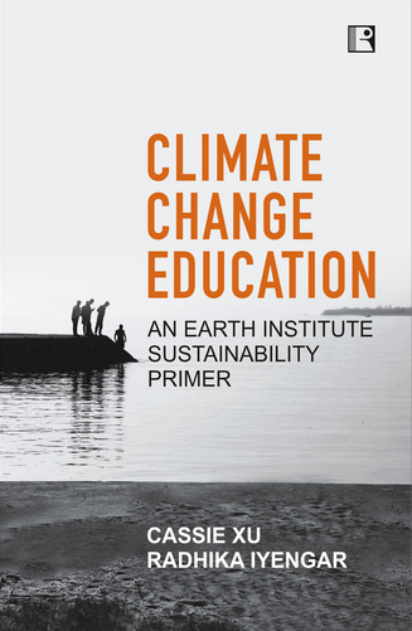[Review] Climate Change Education: An Earth Institute Sustainability Primer
Climate Change Education "offers a compelling and thorough exploration of how to seamlessly integrate climate education across diverse settings, championing a holistic, interdisciplinary approach that drives real, meaningful change," our reviewer writes.
Luo Cassie Xu and Radhika Iyengar’s book serves as an essential primer for teachers and administrators on climate change education, skillfully bridging the gap between complex scientific research and everyday understanding. Collaborating with physical and social scientists, they explore educational contexts ranging from formal classrooms to community learning environments. They emphasize the critical role of structural inequalities in shaping how climate change impacts different populations, offering a comprehensive and inclusive approach that resonates across all levels of society. This book highlights these disparities and provides actionable strategies for integrating climate education into diverse settings.
 The book begins by defining systems thinking, emphasizing that climate change is a multifaceted issue shaped by history, culture, policy, science, and economics. This interconnectedness makes climate change complex, and systems thinking is essential for understanding this complexity. By encouraging viewing natural, social, and economic worlds as interrelated and dynamic, Xu and Iyengar promote an interdisciplinary learning model that aligns with current educational trends, moving away from siloed subjects.
The book begins by defining systems thinking, emphasizing that climate change is a multifaceted issue shaped by history, culture, policy, science, and economics. This interconnectedness makes climate change complex, and systems thinking is essential for understanding this complexity. By encouraging viewing natural, social, and economic worlds as interrelated and dynamic, Xu and Iyengar promote an interdisciplinary learning model that aligns with current educational trends, moving away from siloed subjects.
Addressing the politicization of climate change in the United States, Xu and Iyengar discuss the range of beliefs from denial to acknowledgment without behavior change. They criticize scare tactics in education, which can create fear rather than foster actionable solutions. Instead, they advocate for practical, solutions-oriented education to motivate meaningful behavioral change. Knowledge alone is insufficient to drive change, as explained by the Knowledge, Attitudes, and Behavior (KAB) framework. Emotional connections and a sense of purpose are essential. Integrating social-emotional learning into climate education can shape attitudes and connect climate action to traditional ways of life and community well-being, creating a holistic approach that overcomes psychological and ideological barriers.
The United Nations Education for Sustainable Development (ESD) framework is presented by the authors as a model for active, interdisciplinary learning. ESD promotes critical thinking and social critique, integrates sustainability across the curriculum, and involves teacher development, student leadership, and campus sustainability. This approach aligns with the sustainability elements of the Next Generation Science Standards (NGSS) and underscores the importance of embedding sustainability into all aspects of school life.
Xu and Iyengar also emphasize the need to address climate education within the context of disparities in access to quality education, both within the US and internationally. Integrating climate education with efforts to make education more equitable and inclusive is essential. The COVID-19 pandemic has highlighted the importance of social-emotional learning (SEL) for student success in a world increasingly filled with stress and conflict; encouraging empathy and teamwork is crucial for addressing complex issues like climate change.
The book advocates for a series of approaches to climate change education that offer opportunities to tackle real-world problems, work with peers and community members, and acknowledge lived experiences. Effective strategies are highlighted as project-based learning (PBL), collaborative learning, and inquiry-based learning. PBL allows for interdisciplinary exploration, mirroring real-world problem-solving. Collaborative learning brings diverse perspectives, fostering creativity and innovation. Inquiry-based learning helps students understand the scientific method and develop greater trust in science. Service learning is another effective method, integrating climate education into K–12 schools by combining classroom instruction with community service. This approach promotes civic responsibility and empowers students to make tangible impacts, reinforcing the importance of sustainability.
Case studies, such as Dublin’s “Creating Futures” module and New Jersey’s comprehensive climate change education program, demonstrate the benefits of interdisciplinary teaching and real-world application. Tackling real-life issues usually involves subject-matter knowledge, clear verbal and written communication, and interdisciplinary educational approaches teach students to apply different types of skills and modes of thought. These case studies align with the ESD framework’s goals and highlight the importance of fostering a deeper understanding and personal connection to climate issues.
Xu and Iyengar conclude by emphasizing the importance of diversity, equity, and inclusion in addressing social and environmental justice within climate education to truly address the pressing challenges of climate change, it is essential for us to prioritize climate justice and the inclusion of marginalized populations in our research and policy initiatives. The fight against climate change is inseparable from broader social justice issues, and our education systems must adapt to reflect this complexity in order to create a more equitable and sustainable future.
The Columbia Climate School’s contributions to climate change education are highlighted as a significant example. Established as the nation’s first climate school, it offers interdisciplinary programs and initiatives that support innovative research and connect academic work to real-world applications. The school engages in K–12 education initiatives, professional learning opportunities, and pre-college programs, making climate education accessible at various levels and fostering a culture of sustainability and inclusion.
Climate Change Education is a must-read for educators, policymakers, and anyone passionate about climate change and education. It offers a compelling and thorough exploration of how to seamlessly integrate climate education across diverse settings, championing a holistic, interdisciplinary approach that drives real, meaningful change.









